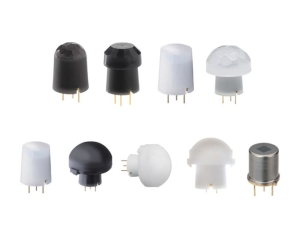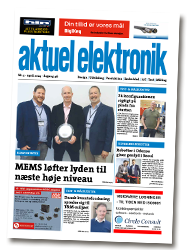 Panasonic Automotive & Industrial Systems Europe has today announced the technologies that the company will be presenting at SENSOR+TEST. The trade fair, which will take place from 31 May to 1 June 2017 in Nuremberg, is a forum for sensors, measuring and testing technologies. At Stand 1-210 in Hall 1, Panasonic will showcase its industry-leading innovations – including sensors, wireless modules and the peer-to-peer IoT framework “OpenDOF” which can enhance the efficiency and reliability of numerous applications.
Panasonic Automotive & Industrial Systems Europe has today announced the technologies that the company will be presenting at SENSOR+TEST. The trade fair, which will take place from 31 May to 1 June 2017 in Nuremberg, is a forum for sensors, measuring and testing technologies. At Stand 1-210 in Hall 1, Panasonic will showcase its industry-leading innovations – including sensors, wireless modules and the peer-to-peer IoT framework “OpenDOF” which can enhance the efficiency and reliability of numerous applications.
For this year’s SENSOR+TEST, Panasonic Automotive & Industrial Systems has put together a selection of the most exciting products from its sensor portfolio for industrial applications. Along with H2 sensors, PM2.5 dust sensors, pressure-sensitive switches and magneto-resistive sensors, Panasonic will be exhibiting the following sensor solutions:
Grid-EYE 64-pixel IR sensor – smallest and most affordable 64-pixel – all in on chip – thermal imaging camera
With the new types (AMG8833, AMG8834, AMG8853 and AMG8854) of the second generation of the Grid-EYE sensor, Panasonic offers improved temperature resolution (NETD –Noise Equivalent Temperature Difference) of ±0.16 °C at 10 Hz and ±0.05 °C at 1 Hz. The measuring distance for people can thus be increased from 5 m to up to 7 m. In addition to the hardware, Panasonic will demonstrate what you can get out of 64 pixels: people detection, tracking, presence detection, and algorithms for achieving the kind of resolutions that you would expect from expensive thermal cameras with several hundred thousand pixels.
Pressure sensor – for high- and low-pressure measurement
Panasonic will demonstrate its 20 years of expertise in the area of miniature semiconductor pressure sensor solutions with its extensive range of products for precision applications. The range of relative pressure sensors delivers a robust solution for a wide range of applications with a focus on factory automation and medical technology – with or without amplifier. The small, cost-effective design makes it a perfect match for price-sensitive solutions.
Pyroelectric infrared sensors – motion sensors including corresponding lens
Pyroelectric infrared sensors from Panasonic (PaPIRs) are fully developed motion sensors including the corresponding lens. The digital output (TTL & LVTTL) is directly connected to the µC, thus facilitating rapid development cycles. The module product portfolio with over 70 sensor variants offers solutions for just about every known application, from wired to battery-operated applications. Despite miniaturisation of the sensor elements (0.6.mm x 0.6 mm), which equates to a smaller lens, PaPIRs offer impressive detection characteristics (NEP, D*). An improved signal-to-noise ratio as well as aesthetic advantages also ensure excellent reliability.
Wireless – Connect the unconnected
Panasonic Wireless Connectivity-solutions encompass a wide range of technologies, with a focus on helping design engineers increase their product’s speed-to-market. Panasonic Wireless Connectivity solutions allow engineers to quickly extend wireless communication into their feature set without a comprehensive knowledge base of wireless hardware and software design.
The Bluetooth Low Energy (v4.2) module PAN1740 has an extremely small form factor (9.0 mm x 9.5 mm x 1.8 mm) and low current consumption in operating mode (4.9 mA). The module with dialog chip comes with OTP memory, which supports stand-alone operation. Some BLE profiles (e.g. SPPoverBLE) are already available.
The PAN1026A Dual Mode module combines Bluetooth Low Energy (v4.2) and Bluetooth Classic (BR). An SPP is integrated on the Classic side, while for BLE there is a GATT implemented. The integrated EEPROM (32 KB) has a pre-programmed Panasonic MAC/Bluetooth address and can be used to store link keys.
PAN9026 WiFi + Bluetooth combo – the new PAN9026 combines Bluetooth and WiFi in a single module. Along with WiFi Radio 802.11 a/b/g/n (2.4 GHz & 5.0 GHz), the combo module offers BLE (v4.2) and Bluetooth Classic (v2.1 EDR). Simultaneous and independent operation of WiFi and Bluetooth is possible.
Panasonic makes IoT software and patents freely usable thanks to OpenDOF (Open Distributed Object Framework)
Panasonic is contributing to the establishment of an ecosystem for the Internet of Things by making its programs available for use without licence payments. Panasonic is in particular providing a peer-to-peer IoT framework for machine-to-machine communication, upon which other companies can build. It is currently used by Panasonic in home monitoring systems as well as applications for solar energy systems and for retail. Panasonic is providing the source code to the OpenDOF Project, a non-profit organisation that it established for this purpose. OpenDOF (Open Distributed Object Framework) thus provides the missing link for IoT applications. This is a free, open-source framework, which connects different products based on different networking technologies and permits the exchange of data.
For more information, visit our website at: http://eu.industrial.panasonic.com/

